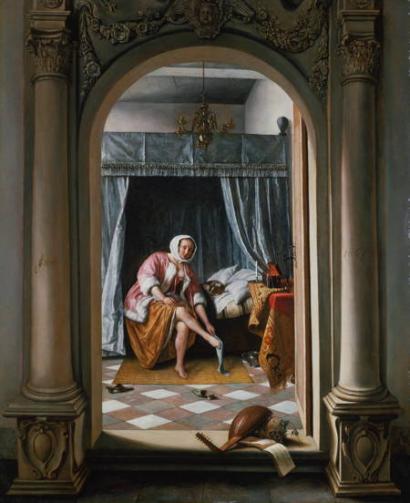
Jan Steen (1626-1679), A Woman at her Toilet, 1663. Oil on panel, 66 x 53 cm.
Royal Collection Trust / © Her Majesty Queen Elizabeth II 2016.
|
|
MAURITSHUIS
Plein 29, 2511 CS
The Hague THE NETHERLANDS
INFORMATION
• Phone: +31 (0)70-302 3456
• Website: mauritshuis.nl
• E-mail: mail@mauritshuis.nl
OPENING HOURS
• Monday 1pm-6pm
• Tuesday through Sunday 10am-6pm
• Thursday 10am-8pm
ADMISSION PRICES
• Adults: €14
• Groups: €12.50
• Young people under 19: free
CURATORS
Desmond Shawe-Taylor (Royal Collection Trust) and Quentin Buvelot (Mauritshuis)
PRESS CONTACT
Natalie Bos
• pressoffice@mauritshuis.nl
• n.bos@mauritshuis.nl
• +31 (0)70 302 3438
• +31 (0)6 14 44 84 60

|
|
The Mauritshuis in The Hague exhibits a selection of the most important Dutch genre paintings from the British Royal Collection. The renowned Royal Collection, held in trust by Her Majesty Queen Elizabeth II, includes highlights by famous painters such as Johannes Vermeer, Gerard ter Borch, Gerrit Dou, Pieter de Hooch, Gabriël Metsu and Jan Steen.
Emilie Gordenker, Director of the Mauritshuis: ‘Never before has such a large group of genre paintings from the British Royal Collection been on view in the Netherlands. It is a great honour to have them in the Mauritshuis for the duration of the exhibition.’ The Royal Collection has some of the most important holdings in the world. It owns many paintings of the Dutch Golden Age, and gives pride of place to its genre paintings, scenes that appear to be taken from everyday life. The exhibition introduces the public to the ‘genre painting’, its many forms and the provocative symbolism it often conceals. These works are stunning in their variety, from simple farmhands gathered in an inn to elegant figures in rich interiors. Some of the everyday scenes carry a deeper, often moralistic meaning, which may be explicit or at times concealed. But in all of them, the artists portrayed the characters and their environments as skilfully as possible, which makes them even more attractive.
The exhibition covers a broad selection of the best Dutch genre paintings from the Royal Collection. It includes 22 paintings from the British Royal Collection and one from the collection of the Mauritshuis, The Young Mother by Gerrit Dou. This painting was part of the British Royal Collection until about 1700, and came into Dutch ownership through King and Stadholder William III. The highlights of the exhibition are Johannes Vermeer's The Music Lesson and Jan Steen's A Woman at her Toilet. Also featured are significant works by other grand masters of Dutch genre painting, such as Gerard ter Borch, Gerrit Dou, Pieter de Hooch, Willem van Mieris and Gabriël Metsu. The Music Lesson is one of the rare 36 surviving works by Johannes Vermeer. This painting dates from 1660-1662, and shows a woman and a gentleman beside a virginal. Above the instrument hangs a mirror, which reflects the foot of Vermeer's easel. Music is undoubtedly a symbol of love in this painting, and this is confirmed by the Latin motto on the virginal. The painting was acquired by King George III of England in 1762, when it was attributed to Frans van Mieris the Elder. Only later was it recognised as a masterpiece by Vermeer. Another highlight in the exhibition is a painting by Jan Steen, which dates from 1663. It was once known as A Woman at Her Toilet. It shows a young woman who, judging by the indents above her calves is pulling her stocking off as her eyes meet those of the viewer. As in Vermeer’s painting, the context can be understood as amorous. Such subjects were extremely popular in their day. Steen makes the point that the physical pleasures are transient by showing a skull in the door opening, under a lute with a broken string.
The Royal Collection and the Mauritshuis The British Royal Collection is one of the largest and most important collections in the world and one of the last great European royal collections to remain intact. The Royal Collection and the Mauritshuis have much in common: both are royal collections and both contain a magnificent collection of Dutch masters of the Golden Age. King George IV of England was a key figure in the history of the Royal Collection. In the early decades of the nineteenth century he acquired many of the paintings which are now seen as jewels in the crown of the English royal collection. The foundations for the Mauritshuis collection were laid by the stadholders William IV and William V. Their descendant, King William I, bequeathed the collection to the Dutch state in 1816 and the museum still bears the name Mauritshuis Royal Picture Gallery.
CATALOGUE
• Masters of the Everyday: Dutch Artists in the Age of Vermeer, by Desmond Shawe-Taylor and Quentin Buvelot. In both English and Dutch, published by Royal Collection Trust, the Mauritshuis and Mercatorfonds, €29,95.
|









